In Search of the Perfect Knife, continued Having determined that I would have to make my own authentic Kephart woodcraft knife, I began looking for a knife blade blank that would work or could be modified to fit the criteria of a historically authentic Kephart. With the internet as my only resource I turned up very little. There is a blank that makes an English Green River knife, which is very close dimmensionally to a Kephart. But the whole blank is only an inch wide and lacks the 1/4 tang knob on the bottom of the handle that Kephart described. It also has serrations along the spine of the blade. Most of the other blanks I found were as shiny as the chrome on a '57 Caddilac and were designed for skinning game, or, more precisely, designed to sit in a drawer or on a shelf. So next I turned to my own knife collection to see if I could find a full tanged something that could be ground down to a Kephart blade.When it came down to if, out of all the knives I owned, most were shiny stainless steel skinning knives. Most had nickel silver or brass bolsters between the blade and the handle. None had the blade profile I was wating. The closest thing I could find was a carbon steel Hudson Bay Trading Company scalping knife from Cold Steel. Studying the design, I saw that it could be cut down to a fairly authentic Kephart. 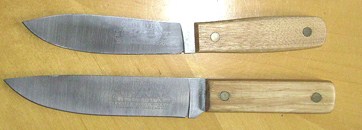 Cold Steel Red River Skinner (top) and Hudson Bay Scalping Knife (bottom), both in Carbon V Steel. Cold Steel has since run out of this particular lot of high carbon steel and has discontinued these knives. I had local knifemaker Johnny Martin cut the scalping blade down to a 4 1/2 inch woodcraft knife. The Red River remains intact. 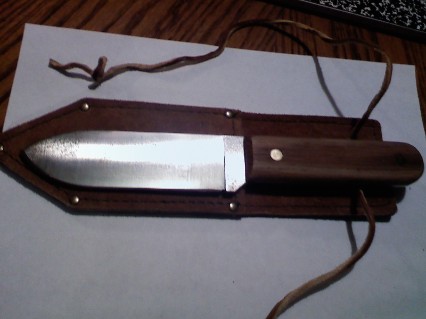 Above is the scalping knife cut down, handle rounded to a knife very similar to ones handcrafters call Kepharts or woodcraft knives. The blade could be cut down to an inch wide and re-handled to be a very authentic Kephart. I have a whole shop of knifemaking equipment given to me by metal fabricator Arlis Albritton years ago and I have since come across a brand new Craftsman band saw that has never been put together but is missing a few parts. I've been meaning for years to arrange and organize this pile of equipment into a knife shop. But I am way too impatient to have waited until all my metal working skills were honed to the point that I could just bop out to the barn and knock out a Kephart. And I hear you can catch Shop Teachers Finger from power tools as well. There's no cure for that. So I drew out a 4 1/2 inch spearpoint on the blade with a pencil and took it to local knifemaker Johnny Martin of JM Knives to be cut down. I left the blade at 1 1/4 inches wide, because I felt it was shame to do otherwise just yet. He was a little bit dubious to begin with, but quickly caught onto what I was describing and seemed amused and supportive of my ideas. Most of the knives he makes are artfully done Damascus blades.When I got the knife back I was way more than pleased. He had cleaned up my pencil line spearpoint and rounded off the butt of the handle. I knew holding it in my hand I had a knife that surpassed my woodcraft skills. Upon using the knife, my suspicions were confirmed. The knife was able to do anything I asked of it. It was able to do every woodcraft chore I tried and in the end it was still razor sharp. But I did began to understand why Kephart insisted on the blade being only 1 inch wide. When cutting notches in green maple sticks, the wide blade had trouble getting down into tight places. The extra width also would make the knife just a little bit less handy than a more narrow one. I went back and forth for several days deciding whether or not to cut down the Cold Steel knife further. I could cut it down to authentic Kephart proportions, stick it in a sheath and be done with it or I could keep it the way it was and just use it. After much debate I decided it would be a sin to cut the knife down any more. It was fine the way it was. It just wasn't a Kephart. I would have to keep looking. Going back to the knife collection yielded nothing. I went online and began looking for anything that could be used, cut down and rehandled, to make a Kephart. It had to be not so hard steel, be able to be cut and ground to the proportions of the Kephart, and had to be cheap. That certainly narrowed things down considerably. The classic machete quickly jumped to the forefront of the search. It was realitively soft steel, had a full tang that could be rehandled and a big blade that could be cut down to most anything you desired. I googled "cutting a machete down to a knife" and found a knife forum where some greenhorn like me asked the same question. Now knife forums are home to a great many experts on metallurgy and woodcraft, one of which bombasted (even including an eyeroll) the tenderfoot for his folly. A machete is not tempered near hard enough, said the knife forum expert. Woodcraft knives started at a hardness of 56-58 on the Rockwell Scale, he said. Kephart never spoke in terms of the Rockwell Scale. The Rockwell Scale was new technology during Kephart's writing career and I'm not sure it ever reached his attention. But he very deliberately decribed a knife blade not tempered too hard, soft enough to be easily sharpened quickly. Not knowing metal fabrication from a hole in the ground I'm not sure where that would fall on the Rockwell Scale, but I have a suspicion its under 56. Most any of those guys on the knife forums know more about it than me, but I doubt any of them surpass the practical woodcraft knowledge of Kephart. So being the uneducated, non-expert greenhorn tenderfioot that I am, I immediately went to the barn and found my old machete. My original intention to have the handle portion of the machete cut down to Kephart proportions. In my head, the knife forum expert kept rolling his eyes. I imagined the whole edge of the cut down machete being curled over the first time I used it, so I decided to put the steel to a field test before I went any further. I drew out one spearpoint on the machete blade attached to the black, hard plastic handle. Then using a carboard pattern I had made, I traced an authentic Kephart further up the spine of the machete. I expected Johnny Martin to roll his eyes too when I took the machete to him to be cut and ground. He didn't. He seemed to actually like my idea about the slightly softer steel. He told me that many older machetes like this one were often made of good steel. When I returned a couple of days later to pick up the knife, Johnny was still positive. I took that to be a good sign since he had had the blade on the grinder. An experienced metal fabricator can gather a pretty good idea about the quality of a certain steel by working it. He had held off on cutting and grinding the Kephart until I saw how the blade cut from the terminus was going to perform. That following weekend came the test for the new blade. Much to my delight, the machete-handled knife cut, sliced, diced, chopped, whittled, carved, hacked, shaved bark, and peeled vegetables for two days straight. The knife was still super sharp. I examined the edge of the blade under a microscope. There were no visible curls or chips at high magnification. The edge did seem to be fuzzy with little bits of material, either microscopic metal filings or particles of the many hardwood sticks and branches I had butchered. Three passes through a handheld ceramic sharpener cleaned off the debris and the knife sliced cleanly through a sheet of laser paper afterwards. The next week I went to Johnny's house to help move a pear tree. I told him of the field tests and asked him to go ahead and finish the Kephart. He already had the blade profile cut out and had begun to grind the tang knob. He asked if I wanted him to handle it or if I wanted to do it myself. My impatience stirred up again and I told him to go ahead and slap a black walnut handle on the knife. That would get the finished knife in my hands that much sooner. |
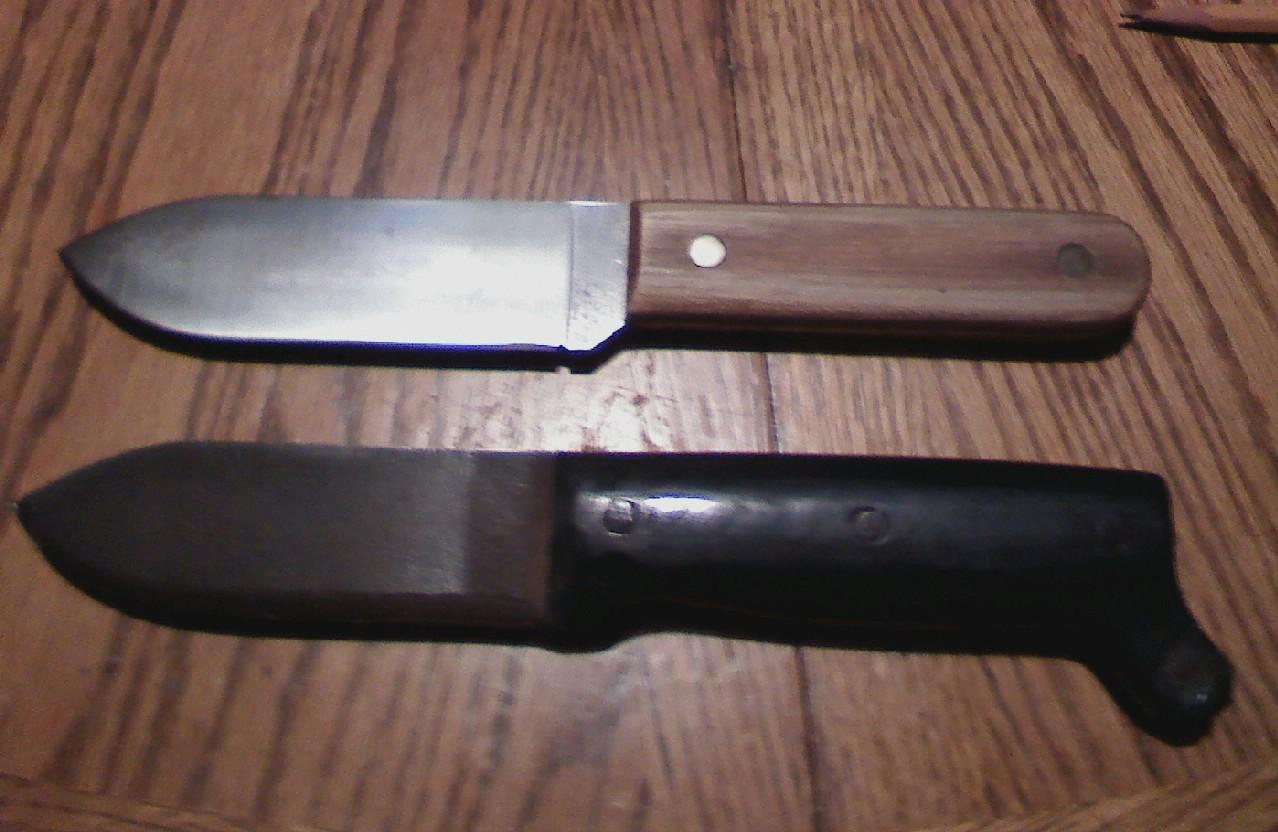 Above are the two test knives (top #1, bottom #2) in comparison, leading up to the authentic Kephart. Both performed beyond my expectations. Yes, the bottom knife was cut from a machete. Please read text before passing judgement. Camp Cookery. The wooden spoon in the Dutch oven was carved onsite in just a few minutes using only the test knife. I did use the pen blade on my jack knife to make the hole in the handle for the leather strip. 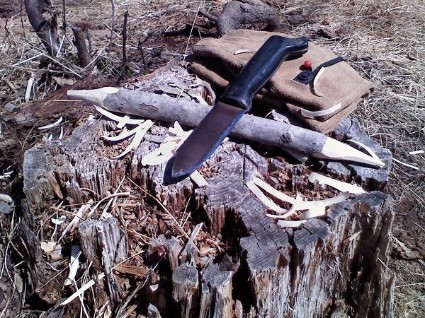 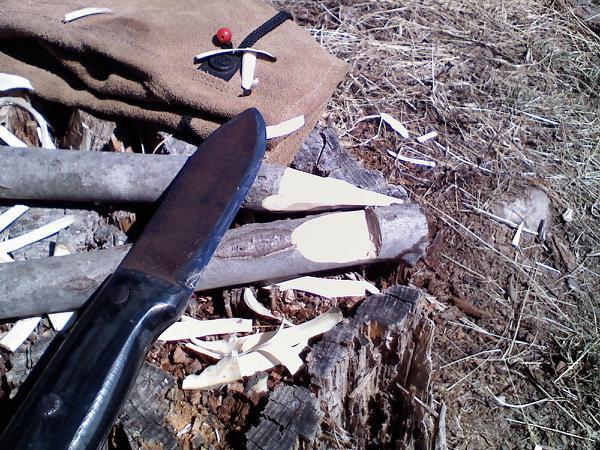 The test knife was able to cut maple pegs for two days without significantly losing edge. Bobcat. |
|
The Johnny Martin Edge. A knife is only as good as the man who uses it. But I also believe good steel, temper and edge are very forgiving of a man's inadequacies. |
||